- The 2023 HR Professional's Stress Index has revealed that human resource professionals encounter a considerable amount of stress from various work-related issues.
- Top stressors include a lack of staffing support, recruitment/hiring, and economic pressures that result in issues related to employee discipline.
- These findings indicate the need for increased support and resources for HR professionals to mitigate their stress levels.
About a 19 min. read
Table of Contents:
Tasks/Responsibilities that Cause Stress
Value Statements Related to a Positive Work Culture
Value Statements Related to a Negative Work Culture
Investing in Employee Benefits & Culture
Survey Overview
The HR Stress Index is a global study measuring stress in the workplace. Our aim is to measure the stress and anxiety of HR professionals and identify the issues that are likely to decrease their productivity and job satisfaction.
Why conduct such a study?
We initially searched for publicly accessible data about how stress impacts HR pros. We didn’t find much in the way of publicly available data, and what we did find drew conflicting conclusions. As we tried to get our hands on some raw survey data, we found it was simply impossible or cost prohibitive. That’s why we chose to invest in this study. By conducting the study ourselves, we can own and analyze the data to our heart’s content, and we won’t have to rely on the good graces of people like data brokers.
While rigorous research requires an investment of time and resources, we’re happy now that we launched this study back in 2020. Since that time we’ve learned a lot, as it all helps us better understand the people we serve in human resources.
Since launching this study, we’ve poured over tons of original data and crunched a mountain of numbers. It’s safe to say we’ve become more or less subject matter experts on the topic of stress among human resources professionals. And we couldn’t be happier.
It’s not as though we’re new to statistics, business data, and behavioral research. Many of our blog subscribers started out by visiting one of our popular pages that curate a vast collection of HR statistics. (See our Employee Engagement & Loyalty Statistics: The Ultimate Collection, or the Ultimate Collection of Employee Benefits and Perks Statistics).
We’ve also conducted other independent research relating to the consumer sector and other verticals we serve such as membership groups, associations, and higher education alumni organizations.
The HR Professional’s Stress Index is funded by Access Development on behalf of Access Perks, a 40-year-old company focused on delivering greater value to all those we serve. But unlike research organizations that charge an arm and a leg for their research data, we thought it was more appropriate to share our findings with not only our valued client partners but with all HR professionals as well.
Our hope is that those who enjoy and appreciate this study will consider including the Access Perks employee discount program in their suite of lifestyle benefits and perks.
Methodology
As with our inaugural study, we consulted with HR professionals and other industry experts who helped us build the survey instrument. That way, we could identify the most pressing issues facing HR professionals today.
The study was conducted from January 2 through February 15, 2023, using both online surveys and telephone interviews. We received 2,732 responses, with respondents representing employers in the Americas, Europe, Asia, Africa, and Australia, with a significant majority of respondents from North America. With such a wide variety of employers participating, survey participants are responsible for serving over 15 million employees.
Because of this high level of participation, the results have a respectable margin of error of plus or minus 1.87 percentage points, giving us a high degree of confidence in the final results.
Demographics
Our respondents represent employers from four primary segments. The largest number of respondents (52%) come from private businesses and corporations. Non-profit and not-for profit organizations represent 19% of respondents, and 13% represent government, education, and other employers in the public sector.
While publicly held entities make up our smallest individual segment representing 13% of respondents, overall they manage roughly five million employees. This compares to the 52% of participants who represent private companies, but they manage a relatively small 3 million total employees.
Respondents have a wide variety of professional experience, with many having ten or fewer years of experience in HR. Some, however, have 45 years or more of HR experience.
The average tenure of respondents is 16 years, and cumulatively they represent 40,544 years of HR experience.
Looking at the average size of the workforce represented by our respondents, the typical (mean) employer size is 310 employees.
Executive Summary
It's clear the pandemic continues to have an impact on HR professionals. How much of an impact is not empirically delineated by the survey data, but we can use the data to make some educated assumptions.
Last year’s study revealed COVID was a significant source of stress for HR professionals. This recent study shows that with the decline in responsibilities related to COVID, we saw a 6% increase in job satisfaction YoY, with 74% of HR professionals reporting they are satisfied with the work they do. Only 30% report they “often consider getting a new job outside of HR,” this is down 19% YoY. The number of comments and concerns about COVID was also down 89% compared to last year.
Yet, although COVID is no longer the crisis it once was, many HR professionals are still coping with the aftermath. The following are direct comments submitted by our respondents:
“Since 2020 and COVID, HR has become significantly more stressful to work in.”
“The challenges I face at work have increased significantly since COVID closures in March of 2020. My role and ability to perform were much more clearly defined beforehand.”
“After Covid, record retirements, changes in our workforce…I am retiring early in the next 30 days.”
“I work in a skilled nursing facility, and I have noticed since Covid that it has been difficult to hire and retain nursing staff.
“(Internal politics) makes for a lot of policy changes that make stress the unknown, on top of the residual COVID staffing issues.”
While the measurable impact of COVID on HR stress appears to be on the decline, other factors continue to have an impact.
Businesses continue to face the issues of lingering inflation and the ongoing war for talent. If you throw in the continued unease related to the banking industry, the Russian/Ukraine war, unending supply chain disruptions, etc., it remains a recipe for stress and anxiety among all types of business professionals, not just those in HR.
Inflation has become a persistent challenge, which naturally creates upward pressure on wages. Many employers have already responded with pay increases, but most pay increases still don't offset inflation. While C-suite executives seek to keep labor costs at a minimum, HR departments can feel the intensifying pressure to compete for talent, but often lack the flexibility to offer competitive wages, meaning key positions go unfilled. These and other issues have a direct impact on work-related stress and job satisfaction.
We see this dilemma manifested in the results of the survey.
Perhaps not surprisingly, the most significant stressor for HR professionals is recruiting/hiring, with 76% reporting it causes either “significant” or “moderate” stress, but this is down 13% from last year.
Other metrics reveal a higher level of job satisfaction that appears to be related to an easing of COVID responsibilities in HR.
For example, 66% of respondents say “dealing with executive’s demands” causes them “significant” or “moderate” stress, but this is down 11% from last year.
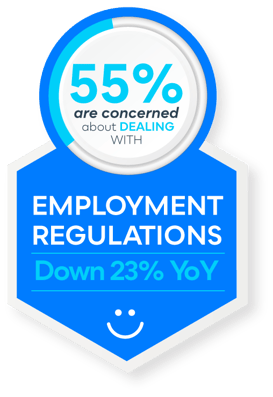 The issue where we saw the most significant drop in stress levels relates to “dealing with employment regulations.” Last year 71% of respondents reported this issue caused significant or moderate stress. This study reveals that the number is down 23% YoY, as only 55% of respondents cite this as a major stressor.
The issue where we saw the most significant drop in stress levels relates to “dealing with employment regulations.” Last year 71% of respondents reported this issue caused significant or moderate stress. This study reveals that the number is down 23% YoY, as only 55% of respondents cite this as a major stressor.
Other indicators of growing job satisfaction as compared to last year’s study, are reflected in these metrics:
- The number of respondents who say they usually go home on time is up 40% YoY.
- HR professionals who strongly agree that their company is dedicated to work/life balance are up 26%.
- Respondents who strongly agree their company has created a positive work culture are up 36%.
- The number of HR professionals who strongly agree that they feel satisfied with the work they do is up 15% over last year.
- Two out of every three respondents believe their HR department has a seat at the company’s strategic table. This is up 4% YoY.
Seeing these positive signs are encouraging and reflect an unexpected increase in overall job satisfaction among HR professionals.
When it comes to working in HR, the biggest issue of greatest concern to our respondents was the issue of “not having enough staff to complete necessary tasks.” This answer topped the list in both years. Last year 58% cited this as their biggest concern. This year, however, that percentage dropped to 49% of respondents, down 15% from last year’s study.
After the issue of being understaffed, we see 48% of respondents indicating they feared “not being able to keep up on (their) workload.” This is down 14% from last year.
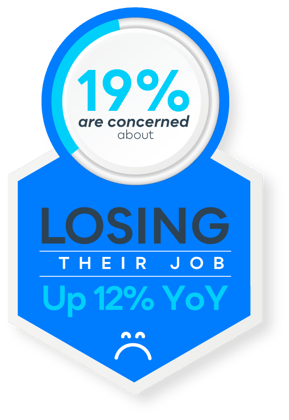 At the bottom of the list of concerns, only 19% of HR professionals we surveyed are “very concerned” or “somewhat concerned,” about losing their job. This is a 12% increase YoY.
At the bottom of the list of concerns, only 19% of HR professionals we surveyed are “very concerned” or “somewhat concerned,” about losing their job. This is a 12% increase YoY.
To break down this metric further, respondents working at very large companies (1501+ employees) are 18% more likely to be concerned about losing their job, as compared to all those surveyed.
As it relates to HR’s integration into the company’s culture, fully 93% report they have a good relationship with their employees, 81% have a good relationship with their senior executives, and 77% state they trust their immediate supervisor. These metrics show little change year over year.
The most significant issues reported in the study relate to employee misbehavior. We found 67% of respondents stating employee discipline is their second most significant concern. This is up 10% over last year. It’s likely this metric reflects the issues related to remote work, and how companies are enforcing their return-to-work policies.
Other metrics show an overall improvement in HR stress. Last year found 19.3% of respondents admit they work in a toxic environment. This year that percentage dropped to 15%.
We also saw last year 19.2% reported they have “too many emotionally charged confrontations” at work. That number is down 23% over last year, with just 15% who agree with that statement.
We’ll dive into more detail on these and other metrics a little later on.
The HR Stress Environment
Respondents were asked to indicate fears and concerns about their work environment.
As stated previously, the biggest concern among HR professionals relates to staffing levels and workload. We see 49% concerned most about not having enough HR staff to complete their necessary tasks. However, this is down 15% over last year. This is followed closely by 48% who fear not being able to keep up with their work. This too is down 14% YoY.
As it relates to job security, we see that only 19% of respondents report being concerned about losing their job, but this is up 12% over last year. Along those same lines, 26% worry about cuts to their HR budget, this concern is also up 21% over last year.
HR professionals aren’t without their concerns, but overall, it seems most in the industry feel quite secure about their position, as 81% don't have significant concerns about losing their job.
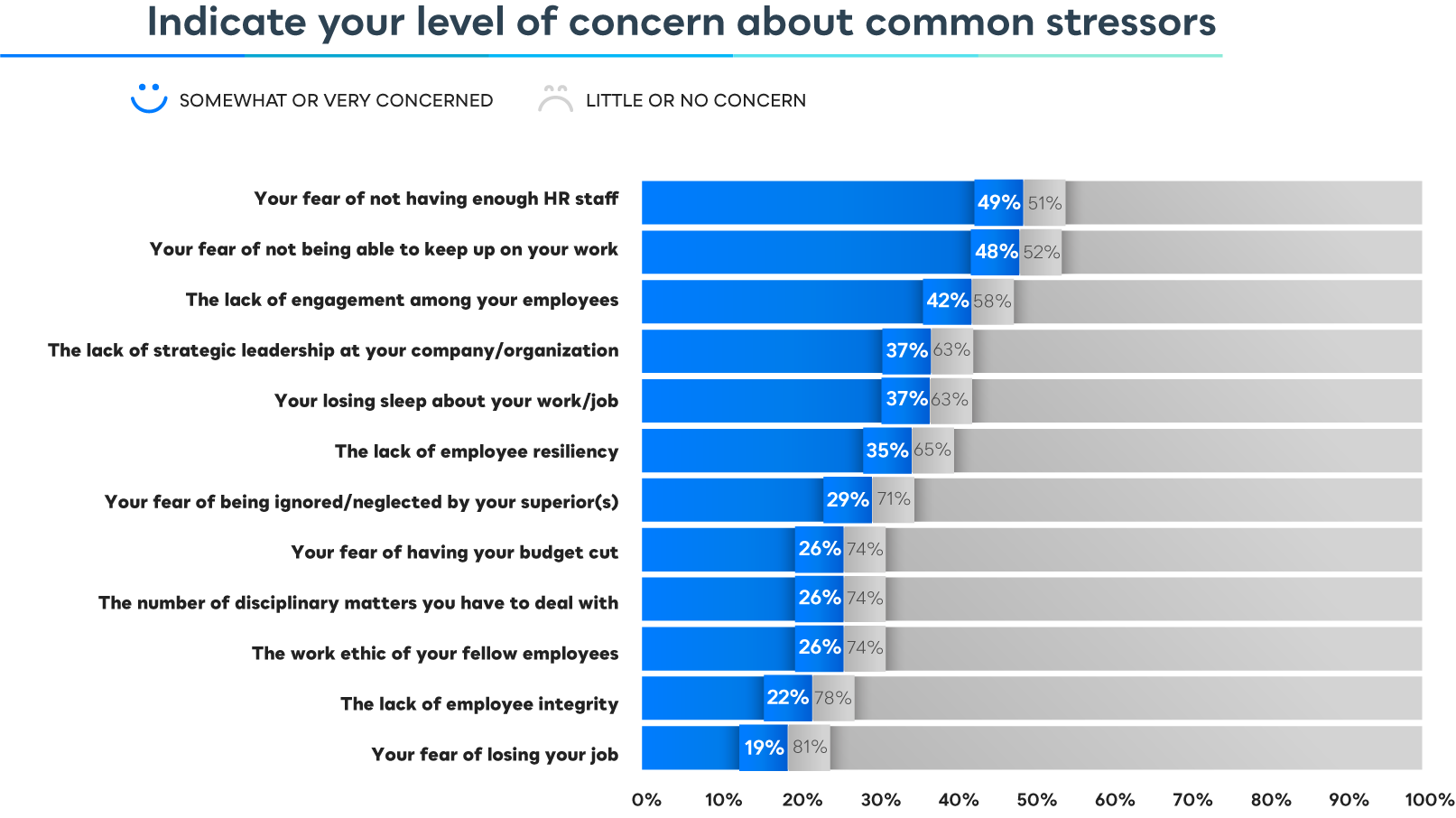
Are you understaffed/overworked? Or do you have misplaced expectations?
Nearly all employees have concerns and worries about our workload and burnout, and those issues are consistent with other studies we’ve conducted. This study reveals that feeling overworked is among the most common issues cited among HR professionals. However, knowing if you are overworked depends a lot on whether or not your company has the right staff-to-HR ratio. Arriving at that metric can be a tricky thing, as calculating it incorrectly can be dangerous to both HR employees and your company.
According to a 2021 study by Indeed, the “standard rule is often 2.57 HR staff for every 100 employees. Small organizations have higher ratios with an average of 3.40. Medium organizations often have ratios around 1.22 while a normal ratio for large organizations is 1.03.” This rule of thumb varies according to the size of your business, and the goal of your department.
An HR expert at PriceWaterhouseCooper says: “If the role is primarily organizational asset preservation—preventing litigation by overseeing policies, cutting HR costs and outsourcing—then a ratio of 1.00 (1 per 100 employees) for large employers is the standard benchmark. If your department's goal is asset creation—an ongoing alignment with business strategy—then the ratio could be near .60 (1 per 166 employees).”
Even if your company is appropriately staffed, you can still feel overwhelmed. That’s why it’s important to arrive at the correct ratio of HR staff to employees for your organization. If you are truly understaffed, that data can empower you to advocate for new staff.
If you are appropriately staffed yet still feel overworked and mentally exhausted, you’ll be more informed about your need to streamline your services, and/or outsource some of your tasks and responsibilities. It may also help you know whether or not you need to modify your expectations or look for work elsewhere.
Tasks/Responsibilities that Cause Stress
Our next question asked respondents to rate the degree of job-related stress they feel when dealing with some of the most common HR tasks and responsibilities. For those that answered “significant” or “moderate” stress, we’ve combined their answers into a single column as seen below:
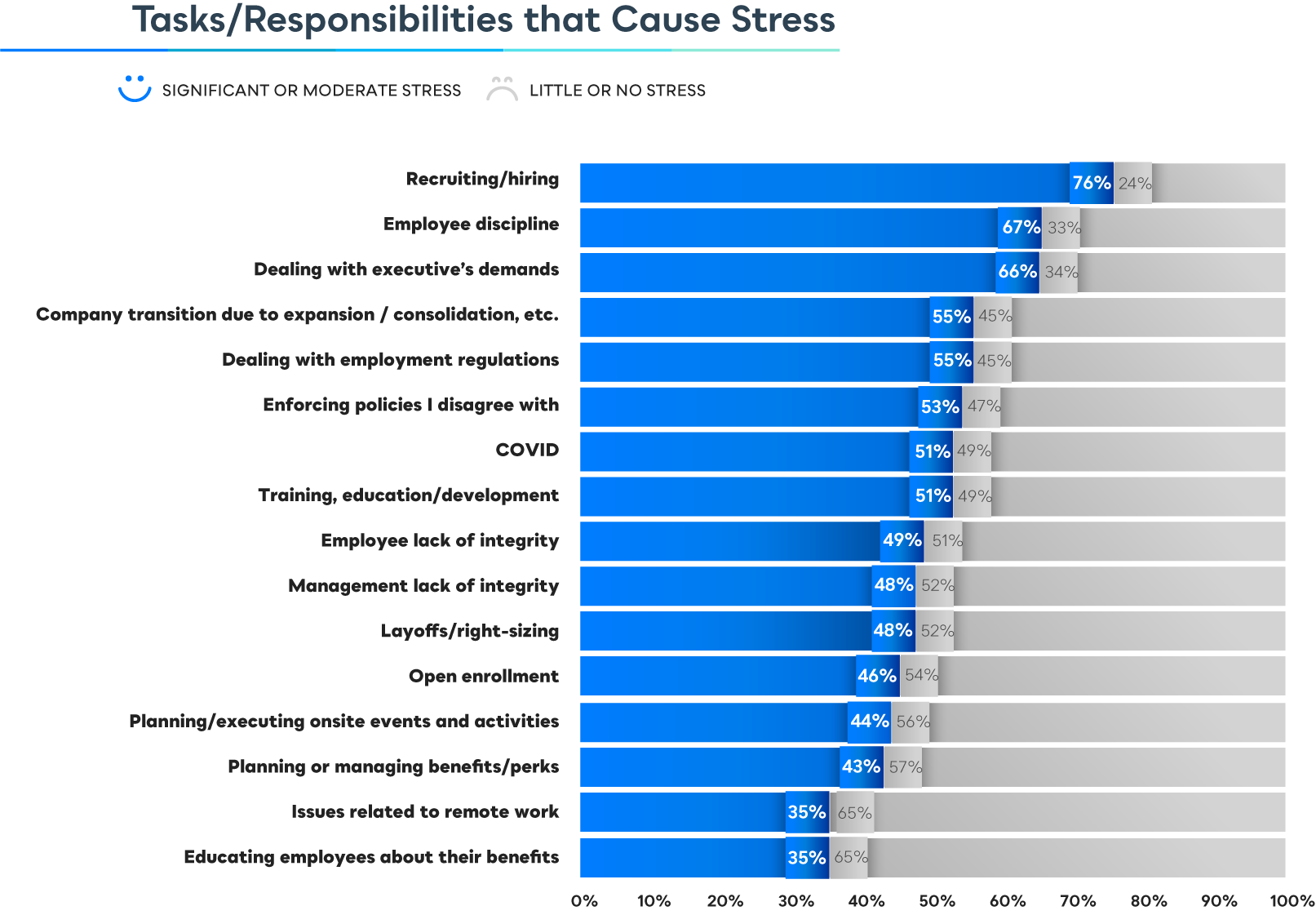
A significant majority of respondents (76%) say recruiting/hiring is currently their most significant source of stress. This ranking mirrors last year’s survey, but the number of respondents who say it’s their top concern is down 13% YoY.
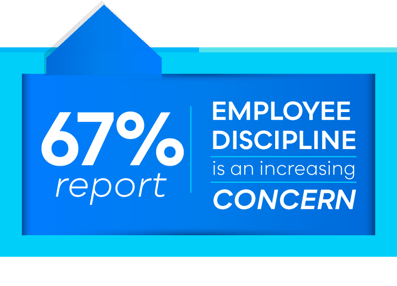 Moving up this year to the second spot on the survey, was the issue of employee discipline. We found 67% citing they are concerned about how frequently they must engage in employee discipline. This is up 10% over last year.
Moving up this year to the second spot on the survey, was the issue of employee discipline. We found 67% citing they are concerned about how frequently they must engage in employee discipline. This is up 10% over last year.
Last year, 74% of HR professionals said “dealing with executive demands” caused them stress. But as the demands of COVID have lifted, that number is down 9% over last year.
The most significant YoY drop relates to “Dealing with employment regulations.” This year 55% reported this as a significant stressor, which is down from 71% last year.
New for this year’s study, we included a question about dealing with issues related to remote work. While overall, 35% of respondents report this issue causes significant concern, the percentage seems to increase commensurate with the size of the company.
Another question we added this year relates to the integrity of both employees and management. Interestingly, about half (49%) of HR professionals believe the lack of employee integrity causes them stress. This remains roughly consistent regardless of the size of the company. That number is also about half of all respondents (48%) when it comes to stress caused by management’s lack of integrity, but that number also increases as the number of employees gets bigger. As compared to the average, respondents at large employers are 11% more likely to feel stress related to management’s lack of integrity, as compared to smaller employers.
Value Statements Related to Positive Company Culture
The next set of questions relates to value statements that are often associated with company culture. When respondents answer in the negative, it can often indicate a higher degree of work-related stress. In the interest of simplifying the results, we’ve included only those answers where respondents "agree" or “strongly agree." The survey asked: Please rate your agreement or disagreement with the following statements:

As far as HR’s relationship with other employees, the good news is that 93% of HR professionals report they have a good relationship with their employees.
This is unchanged from last year. Similarly, we also see 81% reporting they have a good relationship with senior executives; and 67% say they trust their CEO. Both metrics are similar to last year.
We also discovered that more than half (56%) of all HR professionals believe their company is “truly committed” to work/life balance. This is up a significant 14% over last year.
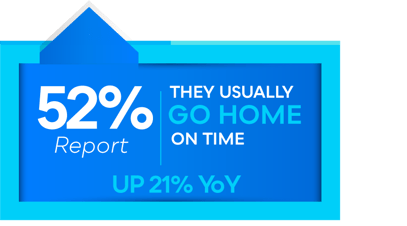 We also see 52% of those working in HR report they usually go home on time. This metric is up a whopping 21% over last year, and again is likely attributable, at least in some degree, to fewer responsibilities and demands related to COVID.
We also see 52% of those working in HR report they usually go home on time. This metric is up a whopping 21% over last year, and again is likely attributable, at least in some degree, to fewer responsibilities and demands related to COVID.
Another important metric that showed significant YoY improvement, was the question related to “I look forward to coming to work.” This year 63% of respondents agreed with that statement, up 11% YoY.
Last year we saw a correlation between HR pros with higher stress levels and not going home on time. In addition, our study revealed those who don't go home on time are:
- 70% more likely to feel dissatisfied with the work they do.”
- 81% more likely to have "too many emotionally charged confrontations."
- 99% less likely to "look forward to coming to work.”
See our article and infographic: What's at Risk when HR Professionals Don't Go Home on Time?
Value Statements Related to a Negative Work Culture
Our final set of value statements relates to situations that when answered in the affirmative, may connote greater job-related stress. We asked: As it relates to your work in HR, please rate your level of agreement or disagreement with the following statements:
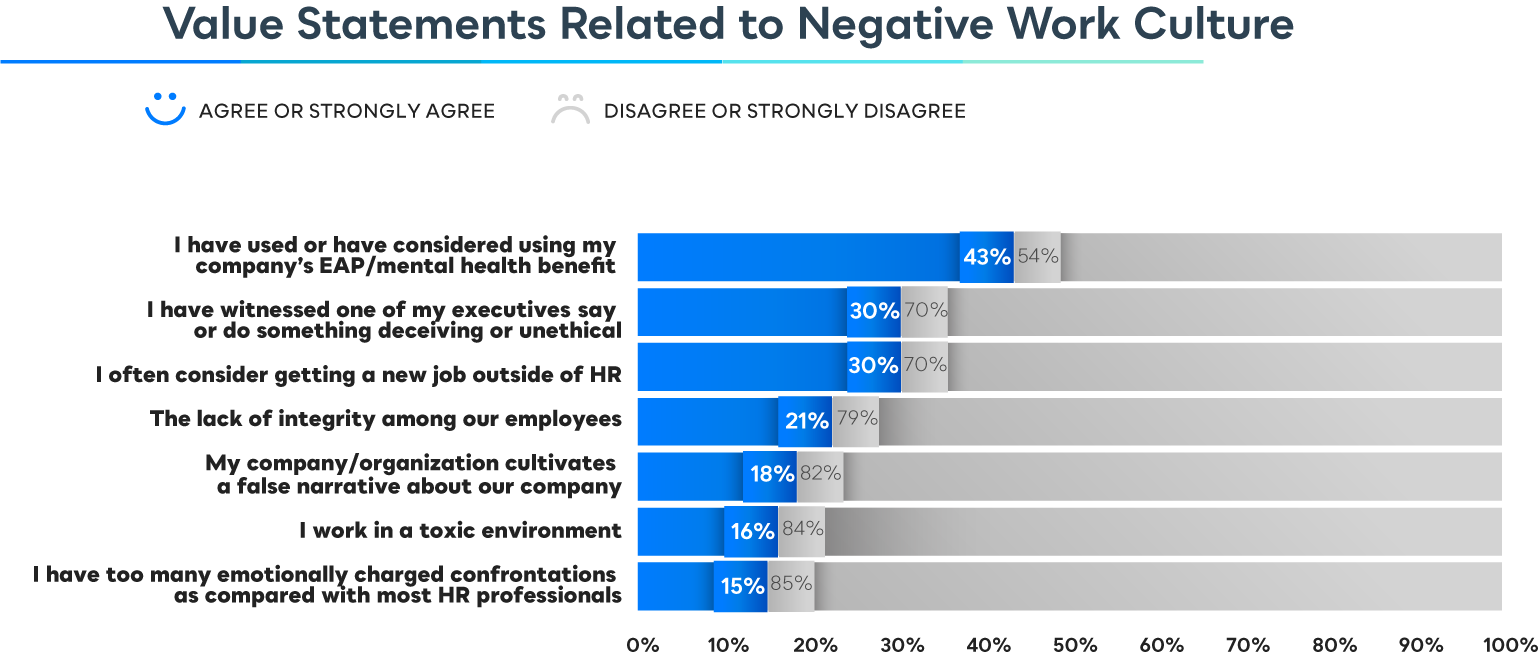
A company’s EAP/mental health benefit is something HR professionals have long encouraged their employees to utilize when the need arises. EAP utilization may be correlated to work-related stress, but it’s problematic to assume a causal relationship. However, the nature of this question implies the usage of the EAP is related “to their work in HR,” making this question necessary and relevant to our study.
Overall, 43% of respondents agree that they’ve used, or considered using their company’s EAP. This is consistent with last year’s study and within our margin of error. Interestingly, HR professionals working at large and very large companies are an average of 15% more likely to engage with their EAP, as compared with their colleagues working at smaller organizations. (See our article Which is More Stressful? HR at a Big or Small Company?)
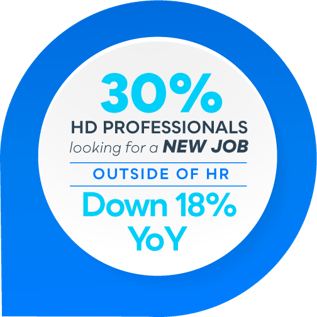 It's also important to note that fewer HR professionals want to find a new job outside of HR. This year 30% agreed with that statement, but this is down 18% over last year.
It's also important to note that fewer HR professionals want to find a new job outside of HR. This year 30% agreed with that statement, but this is down 18% over last year.
The study also saw 16% of respondents reporting they work in a toxic environment. This is down 16% YoY. This also applies to the question about having “too many emotionally charged confrontations,” as 15% of respondents agreed with that statement. This too is down 23% from last year.
Finally, we asked respondents about whether or not their company “cultivates a false narrative.” This year 18% agreed, but this is down from 21% last year, a 16% drop.
Investing in Employee Benefits & Culture
For HR Professionals, when an employer is committed to investing in employee benefits and culture, it can make working in HR less stressful. We asked respondents to rate their employer’s investment in their benefits and culture. The survey asked: When it comes to how your company/organization invests in its employees, please indicate your satisfaction with the following:
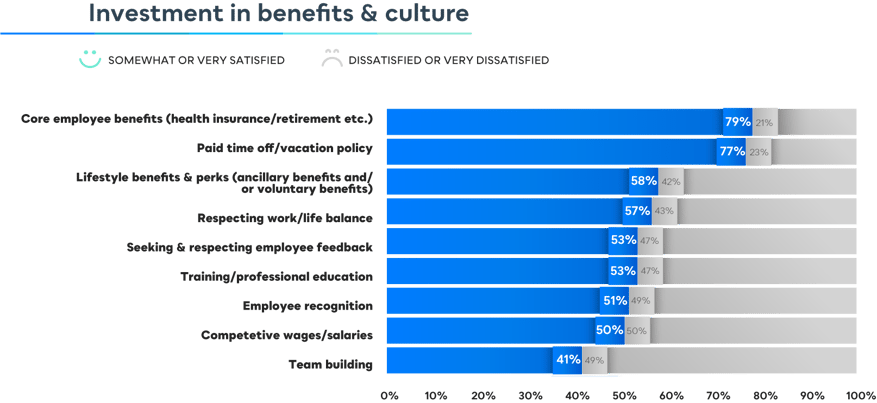
As compared to last year’s study, we saw an increase in the number of respondents who are satisfied with their company’s benefits and culture.
The most significant jump in satisfaction scores relates to respecting work/life balance, going from 44% to 57% YoY, a 28% jump. Team building went from 30% last year, to 41% this year, a 36% increase. The largest overall increase was for employee recognition, where this year 51% are satisfied. That’s up 38% over last year.
Satisfaction with core benefits was up 9%; PTO was up 7%, and wages/salaries were also up 7% year over year.
While the increase in these metrics may seem small, they are statistically significant, given the percentage of change from last year. We anticipate conducting this study for the foreseeable future and will keep a close eye on how industry professionals respond over time.
What's Your Take?
We invite you to share your insights and opinion about his study. What's causing you the most stress in your HR position? Is there anything you've found surprising in this data? Add your comments below.
About Access Perks®
As a division of Access Development®, Access Perks is a value-added lifestyle benefit that helps thousands of HR professionals, benefits specialists, and employers boost employee engagement, recruiting, and retention. Using America’s largest, private discount network, Access Perks is a unique employee discount program delivering deep discounts on everyday purchases such as at popular sit-down restaurants, department stores, and online retailers, as well as discounts on things like groceries, gas, pizza, oil changes, hotels, theme parks, cell phones, etc. With over 1 million locations globally, employees who use the program regularly can save upwards of $1,000 or more per year, regardless of where they live, work, or travel. To learn more, go here.

Creative Commons Attribution-ShareAlike (CC BY-SA) This license permits remixing, repurposing, and building upon this work providing “Access Perks®, HR Stress Index” is clearly and obviously credited. Any new creation that references, or is derived, in whole or in part, from this work, must also be licensed using identical terms. All other permissions requests must contact:
1012 W. Beardsley Place
Salt Lake City, UT 84109
888-438-2318





